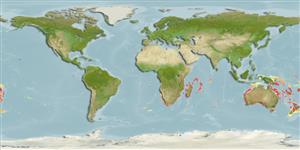Actinopterygii (ray-finned fishes) >
Scorpaeniformes (Scorpionfishes and flatheads) >
Scorpaenidae (Scorpionfishes or rockfishes) > Scorpaeninae
Etymology: Phenacoscorpius: Greek, phenax, -akos = deceptive + Greek, skorpion = scorpion (Ref. 45335). More on author: Norman.
Environment / Climate / Range
Ecology
Marine; bathydemersal; depth range 139 - 736 m (Ref. 92845). Deep-water, preferred ?
Indo-West Pacific.
Size / Weight / Age
Maturity: Lm ? range ? - ? cm
Max length : 10.0 cm TL male/unsexed; (Ref. 26165)
Short description
Morphology | Morphometrics
Dorsal
spines
(total): 12;
Dorsal
soft rays
(total): 8-9;
Anal
spines: 3;
Anal
soft rays: 5. This species is distinguished by the following set of characters: pectoral-fin rays 16-18 (mode 17) with middle rays branched in young and adults; pored lateral-line scales 2-8 (mode 3) with last pored scale situated from below second to fifth dorsal-fin spine base; longitudinal scale series about 50 rows; gill rakers 17-21 (mode 19); presence of palatine teeth; distinct nuchal and parietal spines; suborbital spines 3-5 (mode 5); the nape and anterior part of body moderately arched throughout life; relatively short post-nuchal-spine length, 3.2-9.5% (mean 5.7%) of SL; relatively long caudal-fin length, 23.4-30.7% (mean 26.7%) of SL; black spots on posterior half of caudal peduncle 5-37 (mode 8); body of preserved specimens with 4 distinct saddles (Ref. 92845).
Rare species.
Life cycle and mating behavior
Maturity | Reproduction | Spawning | Eggs | Fecundity | Larvae
Eschmeyer, W.N., 1986. Scorpaenidae. p. 463-478. In M.M. Smith and P.C. Heemstra (eds.) Smiths' sea fishes. Springer-Verlag, Berlin. (Ref. 4313)
IUCN Red List Status (Ref. 115185)
CITES (Ref. 94142)
Not Evaluated
Threat to humans
Harmless
Human uses
More information
Common namesSynonymsMetabolismPredatorsEcotoxicologyReproductionMaturitySpawningFecundityEggsEgg development
Age/SizeGrowthLength-weightLength-lengthLength-frequenciesMorphometricsMorphologyLarvaeLarval dynamicsRecruitmentAbundance
ReferencesAquacultureAquaculture profileStrainsGeneticsAllele frequenciesHeritabilityDiseasesProcessingMass conversion
Tools
Special reports
Download XML
Internet sources
